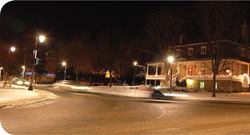From left, clockwise: Guy Carignan, John-Pierre Desrochers, and …
Maintenance. Because each street-light is in communication with the segment controller, and any central control system, operation and maintenance personnel can tell immediately when there’s a malfunction or a lamp burns out. The ability to monitor the entire system also provides an informational basis for scheduling preventive and replacement maintenance.
Additional benefits. Carignan says that in addition to reducing energy used by the street-lighting system, having data on how much energy is being used over time gives the city a way to detect illegal connections to the power line. He also can check the accuracy of electricity bills.
Residents are noticing quality-of-life improvements as well.
Carignan tells of one woman who noticed that the new fixtures make her street “quieter than before.” Say goodbye to the hum of magnetic ballasts and hello to a good night’s sleep.
Managed streetlight systems are being considered in other parts of North America as well. A study prepared for the American Chamber of Commerce Executives in March examined the effects of installing managed street-lighting systems in greater Washington, D.C. Experts believe there’s an opportunity to dramatically reduce the region’s carbon footprint and save money.
Assuming $232/streetlight, the total required investment is estimated at $70 million, with a return on investment of five to seven years. The study also projects an annual reduction of carbon dioxide emissions of 77,746 metric tons.
BEYOND STREET LIGHTING
Thinking of managed street lighting as a network rather than a lighting system can open up some interesting possibilities.
For example, once the network is in place, other compatible devices can communicate through the same segment controllers. Data and control infrastructure components such as traffic counters and bus lane signs can operate through the controller.
Taking the concept further, Aldis Inc. of Oak Ridge, Tenn., offers a package system to communities that upgrade traffic-control systems to energy-efficient LED signals and links them through a digital network. Generally based on a 10-year contract, Aldis charges a management fee that includes hardware installation and maintenance as well as computerized status tracking.
This type of program allows communities to make the switch to LEDs all at once without having to bear the financial burden — LED lights cost $60 to $80 compared to $2 to $3 for standard incandescents.








